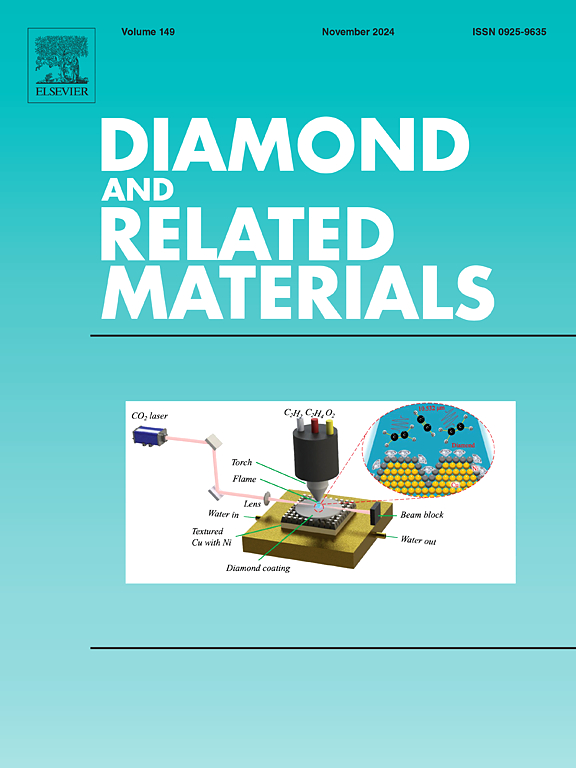重稀土掺镱NiCr填充合金对真空钎焊金刚石显微组织的影响及机理
IF 4.3
3区 材料科学
Q2 MATERIALS SCIENCE, COATINGS & FILMS
引用次数: 0
摘要
本研究提出了一种利用重稀土掺镱NiCr填充合金钎焊金刚石与美国钢铁协会1045 (AISI 1045)之间的方法。首先,研究了不同掺量的Yb对NiCr填充合金组织和性能的影响。Yb的加入改变了NiCr填充合金的组织,促进了粗枝晶向细等轴晶的转变。当Yb掺杂量为1.0 wt%时,填充合金的显微硬度可达738.63 Hv0.2。其次,稀土化合物Ni7Yb2和NiYb3的形成可以有效抑制填充合金中催化元素Ni对金刚石的化学腐蚀。碳化物的大小和形态发生了变化,细小的碳化物有利于提高钎焊接头的质量。特别是当Yb的掺杂量为1.0 wt%时,钎料与金刚石界面的反应更为强烈,碳化物层厚度约为4.26 μm。金刚石磨粒石墨化程度最低,静水强度最高,为3575.7 MPa。摩擦磨损试验后,金刚石磨粒表面形貌完整,氧化铝陶瓷的磨削去除率高达42.7 mg。结果表明,钎焊金刚石具有优良的机械性能和耐磨性。本文章由计算机程序翻译,如有差异,请以英文原文为准。

Influence of microstructure and mechanism of vacuum brazed diamond with heavy rare earth Yb-doped NiCr filler alloy
In this study, a method of brazing connection between diamond and American Iron and Steel Institute 1045 (AISI 1045) using heavy rare earth Yb-doped Ni![]() Cr filler alloy was proposed. Firstly, the effects of different doping amounts of Yb on the organization and properties of Ni
Cr filler alloy was proposed. Firstly, the effects of different doping amounts of Yb on the organization and properties of Ni![]() Cr filler alloy were investigated. The doping of Yb alters the microstructure of the Ni
Cr filler alloy were investigated. The doping of Yb alters the microstructure of the Ni![]() Cr filler alloy, promoting the transformation of coarse dendrites into fine equiaxed grains. When the doping amount of Yb was 1.0 wt%, the microhardness of the filler alloy was up to 738.63 Hv0.2. Secondly, the formation of rare earth compounds Ni7Yb2 and NiYb3 can effectively inhibit the chemical corrosion of diamond by the catalytic element Ni in filler alloy. The size and morphology of the carbides were changed, and the fine carbides were conducive to improving the quality of the brazed joints. Especially when the doping amount of Yb was 1.0 wt%, the reaction between the filler alloy and the diamond interface was more intense, the carbide layer was thicker about 4.26 μm. Diamond abrasive grains had the lowest degree of graphitization and the highest hydrostatic strength of 3575.7 MPa. Moreover, the surface morphology of diamond abrasive grains was intact after the friction wear test, and the removal amount of alumina ceramics by grinding was up to 42.7 mg. It is shown that the brazed diamond has excellent mechanical properties and wear resistance.
Cr filler alloy, promoting the transformation of coarse dendrites into fine equiaxed grains. When the doping amount of Yb was 1.0 wt%, the microhardness of the filler alloy was up to 738.63 Hv0.2. Secondly, the formation of rare earth compounds Ni7Yb2 and NiYb3 can effectively inhibit the chemical corrosion of diamond by the catalytic element Ni in filler alloy. The size and morphology of the carbides were changed, and the fine carbides were conducive to improving the quality of the brazed joints. Especially when the doping amount of Yb was 1.0 wt%, the reaction between the filler alloy and the diamond interface was more intense, the carbide layer was thicker about 4.26 μm. Diamond abrasive grains had the lowest degree of graphitization and the highest hydrostatic strength of 3575.7 MPa. Moreover, the surface morphology of diamond abrasive grains was intact after the friction wear test, and the removal amount of alumina ceramics by grinding was up to 42.7 mg. It is shown that the brazed diamond has excellent mechanical properties and wear resistance.
求助全文
通过发布文献求助,成功后即可免费获取论文全文。
去求助
来源期刊

Diamond and Related Materials
工程技术-材料科学:综合
CiteScore
6.00
自引率
14.60%
发文量
702
审稿时长
2.1 months
期刊介绍:
DRM is a leading international journal that publishes new fundamental and applied research on all forms of diamond, the integration of diamond with other advanced materials and development of technologies exploiting diamond. The synthesis, characterization and processing of single crystal diamond, polycrystalline films, nanodiamond powders and heterostructures with other advanced materials are encouraged topics for technical and review articles. In addition to diamond, the journal publishes manuscripts on the synthesis, characterization and application of other related materials including diamond-like carbons, carbon nanotubes, graphene, and boron and carbon nitrides. Articles are sought on the chemical functionalization of diamond and related materials as well as their use in electrochemistry, energy storage and conversion, chemical and biological sensing, imaging, thermal management, photonic and quantum applications, electron emission and electronic devices.
The International Conference on Diamond and Carbon Materials has evolved into the largest and most well attended forum in the field of diamond, providing a forum to showcase the latest results in the science and technology of diamond and other carbon materials such as carbon nanotubes, graphene, and diamond-like carbon. Run annually in association with Diamond and Related Materials the conference provides junior and established researchers the opportunity to exchange the latest results ranging from fundamental physical and chemical concepts to applied research focusing on the next generation carbon-based devices.
 求助内容:
求助内容: 应助结果提醒方式:
应助结果提醒方式:


